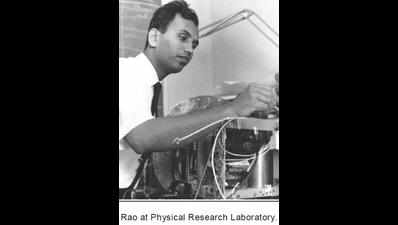- News
- City News
- ahmedabad News
- Ex-chairman of Isro U R Rao dies at 85
Trending
This story is from July 25, 2017
Ex-chairman of Isro U R Rao dies at 85

AHMEDABAD: Former Isro chairman U R Rao’s demise on Monday left many scientists at the Physical Research Laboratory (PRL) and Isro’s Space Applications Centre (SAC) in a state of grief. Rao, 85, died at his residence in Bangalore. He was suffering from age related illness. In his last days, professor Rao had been taking keen interest in PRL’s affairs as the chairman of its governing council, and had stepped down only a few months ago.
Rao steered India’s satellite programme after Vikram Sarabhai’s death and led a team of young scientists — all aged 25 years at the time to launch India’s first satellite, ‘Aryabhatta’.Professor Rao, along with his colleagues, had just 36 months to conceive, design ,build, and test the Aryabhatta satellite.
Prof Rao was the man who led the talks with USSR for the launch of India’s satellite on May 10, 1972. About 200 scientists were involved in the satellite team. Later, in a journal, Rao recalled, “We worked night and day in asbestos-roofed sheds with practically no infrastructure. There were more bullock carts on the road than cars.”
The X-ray experiment he developed himself in the PRL was on board this satellite. After Aryabhatta, as first director of the ISRO Satellite Centre, Bangalore, Rao went on to conceive the experimental remote sensing satellites, Bhaskara 1&2, Rohini D2 and technology satellites in the SROSS series the foundation for Indian Remote Sensing Satellites (IRS). He successfully delivered India’s first experimental communication satellite, Apple — the precursor to Indian National Satellites (INSAT) series.
“His imprint can be found on Chandrayaan, and from MOM missions to the upcoming Venus mission where he was involved in developing scientific experiments meant to be conducted by the mission. He lived Sarabhai’s dream,” said Sarkar.
Not only this, Rao was involved in developing payloads of Aditya mission to the sun. He had wondered, “Even now, no one is able to satisfactorily give a reason as to how the temperature shoots up from thousands of degrees in sun’s chromosphere to millions of degrees in the coronal region through the transition zone within no time, and what sensors with what sensitivity are needed to capture that event.”
Rao steered India’s satellite programme after Vikram Sarabhai’s death and led a team of young scientists — all aged 25 years at the time to launch India’s first satellite, ‘Aryabhatta’.Professor Rao, along with his colleagues, had just 36 months to conceive, design ,build, and test the Aryabhatta satellite.
Prof Rao was the man who led the talks with USSR for the launch of India’s satellite on May 10, 1972. About 200 scientists were involved in the satellite team. Later, in a journal, Rao recalled, “We worked night and day in asbestos-roofed sheds with practically no infrastructure. There were more bullock carts on the road than cars.”
The X-ray experiment he developed himself in the PRL was on board this satellite. After Aryabhatta, as first director of the ISRO Satellite Centre, Bangalore, Rao went on to conceive the experimental remote sensing satellites, Bhaskara 1&2, Rohini D2 and technology satellites in the SROSS series the foundation for Indian Remote Sensing Satellites (IRS). He successfully delivered India’s first experimental communication satellite, Apple — the precursor to Indian National Satellites (INSAT) series.
Even to this day, former PRL director Utpal Sarkar says Prof Rao was involved directly or indirectly in all of Isro’s contemporary space missions.
“His imprint can be found on Chandrayaan, and from MOM missions to the upcoming Venus mission where he was involved in developing scientific experiments meant to be conducted by the mission. He lived Sarabhai’s dream,” said Sarkar.
Not only this, Rao was involved in developing payloads of Aditya mission to the sun. He had wondered, “Even now, no one is able to satisfactorily give a reason as to how the temperature shoots up from thousands of degrees in sun’s chromosphere to millions of degrees in the coronal region through the transition zone within no time, and what sensors with what sensitivity are needed to capture that event.”
End of Article
FOLLOW US ON SOCIAL MEDIA










